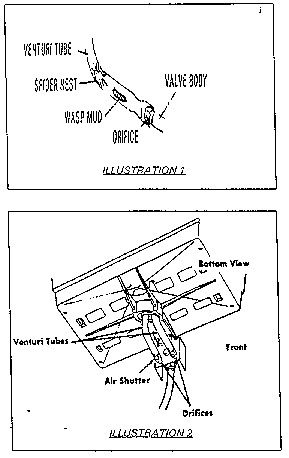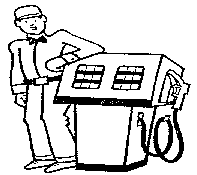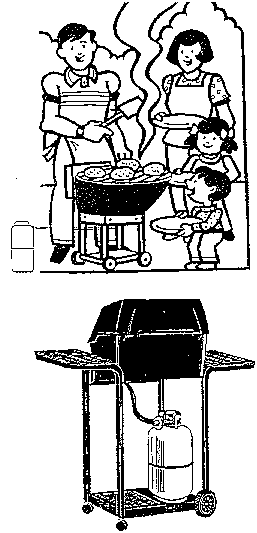INTRODUCTION
Each year, thousands of people pull out their LP gas grills at the start of "barbecuing season." But before firing up the grill, there are several safety precautions to keep in mind. By following these guidelines, you'll help prevent possible gas explosions or fires.
LP gas is flammable. Many accidents occur after the grill has been unused over a period of time, or after a grill's gas container has been refilled and reattached.

SAFETY CHECKS EACH TIME YOU USE THE GRILL
- Check venturi tube (see illustration 1) for blockage by insects, spiders, or food drippings. Clear blockage, either with a pipe cleaner or with a wire. Push any blockages through the tube to the main part of the burner.
- Check grill's hoses for cracking, brittleness, holes, and leaks. Make sure there aren't sharp bends in the hose or tubing.
- Make sure hoses are as far away from the hot surface as possible. Make sure to keep hoses away from areas where grease could drip on them. If you can't move hoses, have a heat shield installed.
- Check connectors (see illustration 2). If scratched or nicked, have them replaced; these conditions can cause leaks.
- Check for gas leaks whenever you reconnect the grill to the LP-gas container, or if you smell gas. To check for leaks, open the gas supply valve fully and apply a soapy solution (one part water, one part liquid detergent) with a brush at connection points. If bubbles appear, there is a leak. Turn off the gas and tighten the connection clockwise. (If it is the tank connection, tighten counterclockwise.) If this does not stop the leak, close the container valve and take the grill to your LP gas dealer or a qualified appliance repair person.
- If a leak is detected, don't attempt to light the grill until the leak has been stopped. If you are using the grill, turn off the gas.
- Make sure there are no lighted cigarettes, matches, or open flames near a leaking grill.
- NEVER USE A GRILL INDOORS. And use the grill at least ten feet away from your house or any building. DO NOT USE THE GRILL in a garage, breezeway, carport, porch, or under a surface that will burn.
- Do not attempt to repair the container valve or appliance yourself. See your LP gas dealer or a qualified appliance repair person.
- Always follow the instructions that accompany the grill.
LP GAS CONTAINER TIPS
When Storing:- Always keep containers upright.
- Never store a spare gas container under or near the grill.
- Never store or use flammable liquids, like gasoline, near the grill.
- Never use or store a gas container indoors.
- Transport the container in a secure, upright position.
- Never keep a filled container in a hot car or car trunk.
- Heat will cause the gas pressure to increase which may open the relief valve and allow gas to escape.
- Unless you have (the preferred) bar-coded container and are filling it at a facility that fills such containers, have the container refilled only by your LP gas dealer or by a qualified service station operator. DO NOT FILL THE CONTAINER YOURSELF.

When Connecting:
- Remove the container valve plug from the container valve.
- Thread the container connector securely into the container valve outlet (turn counterclock-wise).
- Tighten, but do not use excessive force.
- After connected, check for leaks (see above instructions).
- Before disconnecting, turn off the gas burner and container valve.
- Disconnect the container (turn clockwise).
- Place the container valve plug securely into the container valve outlet.
TIPS FOR PURCHASING A GRILL OR GAS CONTAINER
- Buy grills and containers that bear the mark of a nationally-recognized testing laboratory.
